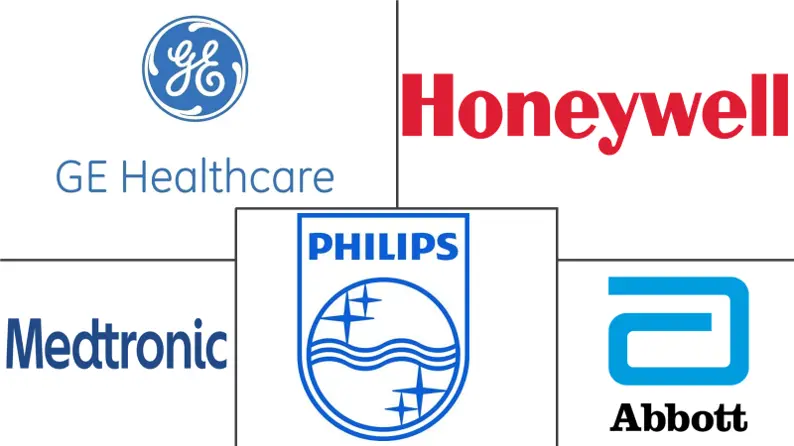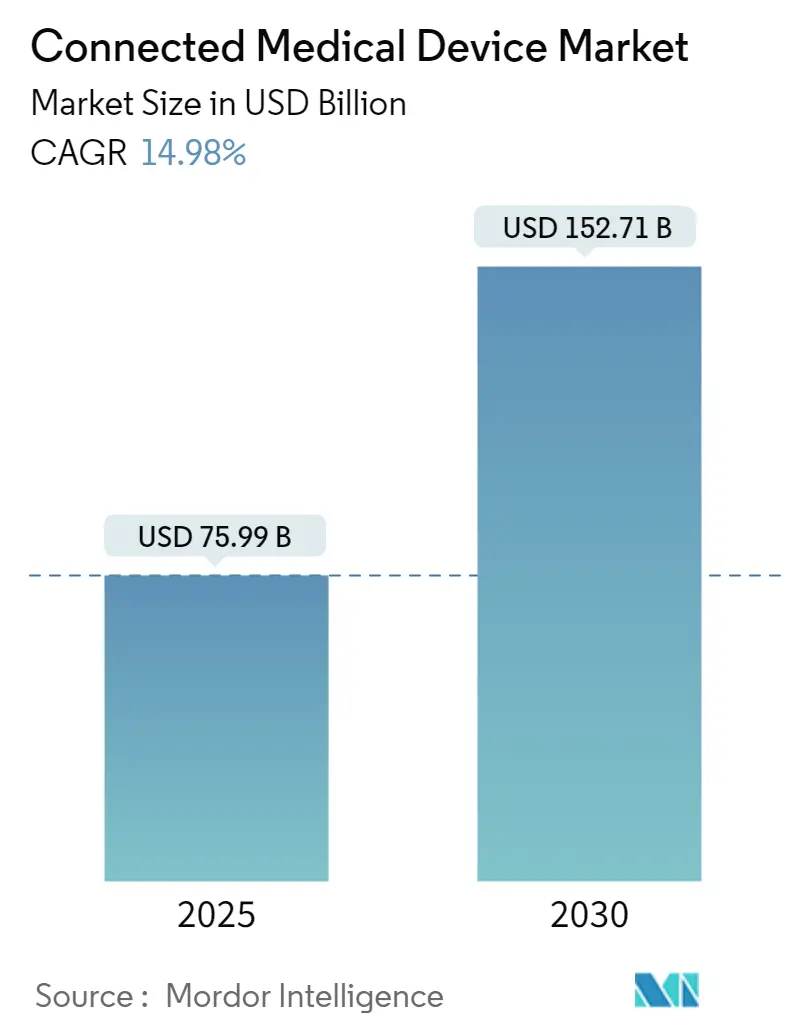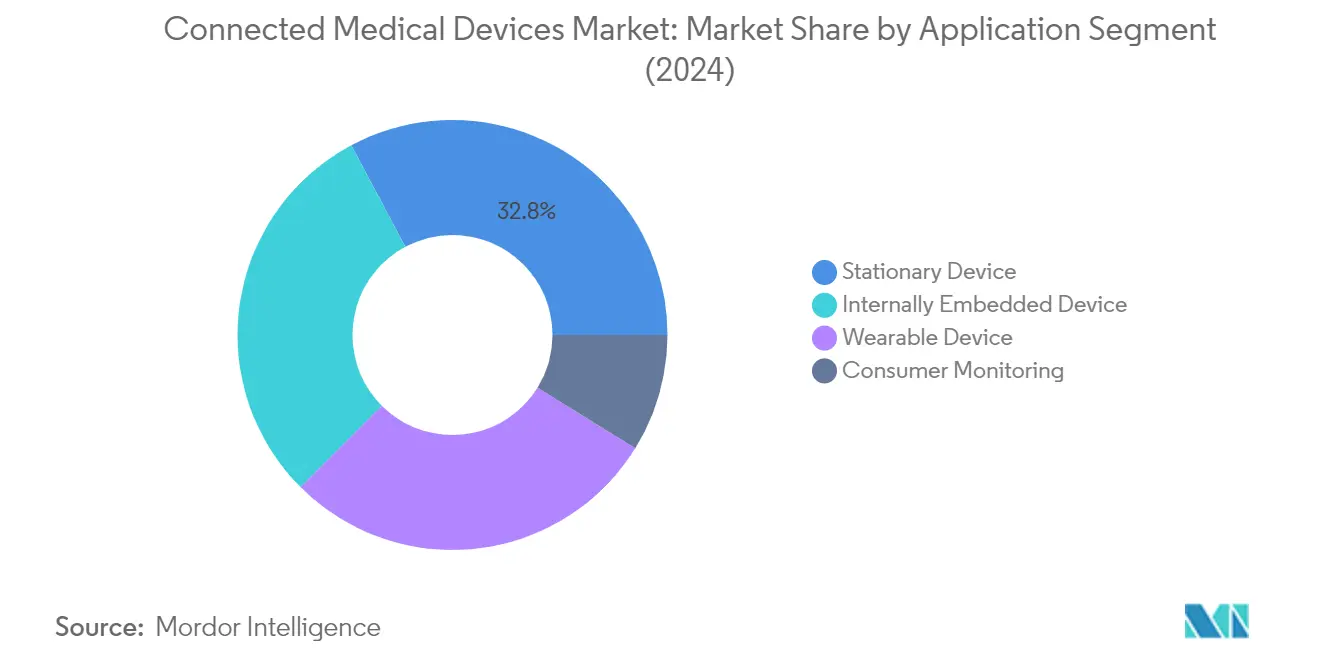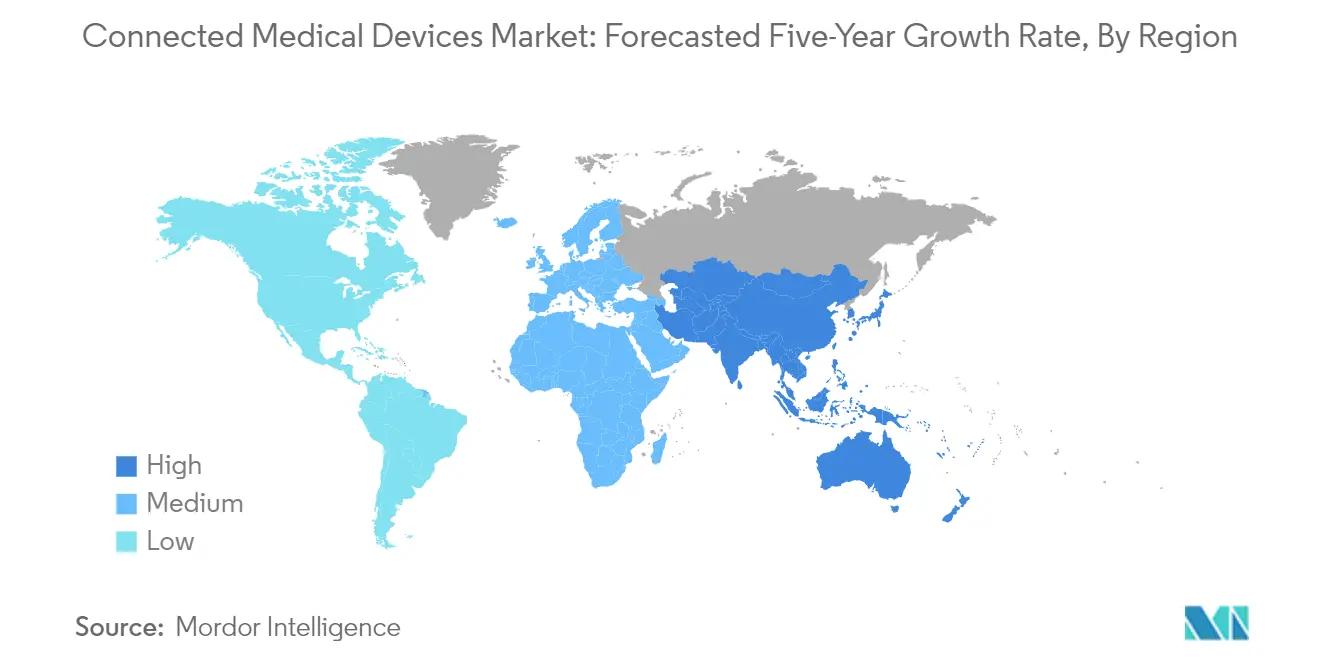Connected Medical Devices Market Size
Connected Medical Devices Market Analysis
The Connected Medical Device Market size is estimated at USD 75.99 billion in 2025, and is expected to reach USD 152.71 billion by 2030, at a CAGR of 14.98% during the forecast period (2025-2030).
The connected medical devices industry is experiencing a transformative phase driven by the convergence of Internet of Things medical device technologies and healthcare innovation. This transformation is reflected in significant healthcare spending patterns, with the National Healthcare Expenditure reaching USD 4.1 trillion, accounting for 19.7% of the US GDP. The integration of advanced computing power, wireless technology, and sophisticated data analytics techniques has revolutionized the analysis of complex heterogeneous medical data, including genomics, proteomics, and pharmacogenomics. The industry's evolution is further supported by projections indicating healthcare spending will grow at an annual rate of 5.4% to reach USD 6.2 trillion by 2028, demonstrating the sector's robust expansion and growth potential of the medical device industry.
The market is witnessing a paradigm shift in healthcare delivery models, with technological integration opportunities emerging throughout the device lifecycle, from manufacturing to maintenance and usage. Connected medical device manufacturers are increasingly incorporating artificial intelligence (AI) and machine learning (ML) capabilities into their products, creating more intelligent and responsive healthcare solutions. This integration enables real-time monitoring, predictive maintenance, and enhanced patient care outcomes. The industry's readiness for disruption is evident in the emergence of sophisticated medical devices that can autonomously manage various health conditions and communicate seamlessly with healthcare providers.
A notable trend in the connected healthcare market is the increasing focus on preventive healthcare and self-monitoring capabilities. The US Center for Disease Control and Prevention's target of increasing life expectancy to 74.4 years has prompted manufacturers to develop more sophisticated monitoring and preventive care devices. This shift is accompanied by growing consumer awareness and preference for lifestyle monitoring and health management tools, driving innovation in wearable and home-based medical devices that enable proactive health management and early detection of potential health issues.
The industry is experiencing significant investment flows and regulatory support, particularly in emerging markets. For instance, India's medical device sector has attracted substantial foreign direct investment (FDI) totaling USD 2.23 billion, reflecting growing international confidence in the potential of the global medical device market. Manufacturers are focusing on developing interoperable solutions that can seamlessly integrate with existing healthcare infrastructure while maintaining high standards of data security and patient privacy. This evolution is supported by advances in wireless technology, cloud computing, and edge processing capabilities, enabling more sophisticated and reliable connected medical devices that can operate effectively in various healthcare settings.
Connected Medical Devices Market Trends
Increase in the Adoption of Data Analytics in the Healthcare Sector
Healthcare analytics has emerged as a crucial tool for analyzing current and historical industry data to predict trends, improve outreach, and better manage the spread of diseases. According to the Society of Actuaries (SOA), 60% of healthcare executives have implemented predictive analytics within their organizations, with nearly two-thirds of executives anticipating that predictive analytic tools will reduce organizational costs by 15% or more by 2023. The integration of data visualization and predictive modeling has enabled physicians to gain useful insights into patient risk assessment and resource utilization, leading to improved quality of care and patient outcomes. For instance, medical device company Medtronic has collaborated with IBM to create a mobile personal assistant application that provides real-time glucose insights for individuals with diabetes, allowing them to make more informed decisions about their medication based on millions of data points.
The implementation of data analytics in medical imaging devices has revolutionized diagnostic capabilities through machine learning applications. Smart imaging devices are now being connected to vast image libraries and patient health records, enabling them to make correlations between image characteristics and health outcomes that humans might overlook. Organizations like ELSO (Extracorporeal Life Support Organization) are leveraging clinical registries to share real-time data from more than 700 centers worldwide, helping device manufacturers understand device performance in real-world settings. Additionally, solutions like Capsule Technologies' Reporting and Analytics provide several tools for the assessment of measurements and alarms collected by medical devices, facilitating evidence-based and personalized care through visualizations, dashboards, and reports of moment-by-moment patient states.
Reduction of the Total Cost of Sensing Devices
The medical device industry is witnessing a significant transformation in cost structures, particularly in sensing technologies. Currently, sensors can cost up to $15 per patient for disposable or specialty sensors and roughly $70 to $250 for reusable or continuous monitoring sensors, showing a wide range of price points to suit different healthcare needs. A breakthrough development from UC Berkeley engineers has introduced a new technique for making wearable sensors that enables medical researchers to prototype and test new designs much faster and at a far lower cost than existing methods. This novel approach, which replaces photolithography with a $200 vinyl cutter, has slashed the time to make small batches of sensors by nearly 90% while cutting costs by almost 75%, making the technology more accessible for research and development.
The industry is experiencing a shift toward cost-effective platforms that combine wearables with smart devices and domestic Internet of Things (IoT) technology, making independent living safer and more practical for elderly people. Companies are actively developing affordable solutions, as demonstrated by initiatives like EVYA in India, which promises to offer users comprehensive health monitoring capabilities at an accessible price point. Third-party payors, including private and government programs, are also influencing the cost reduction trend by reevaluating their payment policies to constrain rising healthcare costs. This has led to medical device manufacturers adopting more disciplined price bargaining stances and developing innovative solutions that balance advanced functionality with cost-effectiveness, ultimately making connected healthcare devices more accessible to a broader population.
Segment Analysis: By Application
Stationary Device Segment in Connected Medical Devices Market
The Stationary Device segment dominates the connected medical device market, holding approximately 33% market share in 2024. This segment encompasses connected imaging devices, X-ray systems, mammography equipment, CT and MRI scanners, ultrasound machines, and nuclear imaging devices. These high-capital-cost, high-tech devices are primarily utilized in hospitals, clinics, and diagnostic centers to communicate images wirelessly to clinicians, with the images being integrated into patients' Electronic Health Records (EHRs). The segment also includes in vitro diagnostic instruments (IVD) and is witnessing significant technological advancements with the integration of artificial intelligence and machine learning capabilities for improved diagnostic accuracy and efficiency. This segment is a key component of the diagnostic medical devices market.
Wearable Device Segment in Connected Medical Devices Market
The Wearable Device segment is experiencing the most rapid growth in the connected medical device market, projected to grow at approximately 20% during 2024-2029. This remarkable growth is driven by increasing consumer demand for health monitoring solutions and the expanding integration of advanced technologies like artificial intelligence and IoT in wearable medical devices. The segment's growth is further supported by the rising adoption of remote patient monitoring systems, increasing focus on preventive healthcare, and the development of more sophisticated biosensors and health tracking capabilities. Insurance companies and healthcare providers are increasingly supporting the adoption of these devices through expanded coverage and integration into regular healthcare delivery systems. This growth is also reflected in the connected wearable patches market.
Remaining Segments in Connected Medical Devices Market
The medical devices market segmentation also encompasses Internally Embedded Devices and Consumer Monitoring segments, each serving crucial roles in the healthcare ecosystem. Internally Embedded Devices include sophisticated medical equipment like smart insulin pumps, cardiac devices, and other implantable monitoring systems that provide continuous patient data to healthcare providers. The Consumer Monitoring segment focuses on remote patient monitoring solutions and telehealth platforms that enable healthcare professionals to track patient vital signs and health metrics from a distance, contributing to more efficient and accessible healthcare delivery systems. These segments provide connected medical devices examples that illustrate the breadth of the smart medical devices market.
Connected Medical Device Market Geography Segment Analysis
Connected Medical Devices Market in North America
North America represents a highly advanced market for connected medical devices, driven by sophisticated healthcare infrastructure, high technology adoption rates, and a favorable regulatory environment. The United States and Canada form the key markets in this region, with both countries showing a strong commitment to digital health transformation. The region benefits from the presence of major medical device manufacturers, established healthcare ecosystems, and significant healthcare expenditure, which collectively drive innovation and adoption of connected medical solutions. The medical device market size by country in North America is a critical factor in understanding regional dynamics.
Connected Medical Devices Market in United States
The United States dominates the North American connected medical devices landscape as the largest market in the region. The market is characterized by the presence of established medical device manufacturers, an advanced healthcare ecosystem, and significant healthcare expenditure. The country's healthcare organizations are increasingly adopting remote patient monitoring solutions and integrating intelligence into medical devices for real-time insights based on patient data. With approximately 84% market share in North America by 2024, the US market is driven by strong regulatory frameworks, increasing integration of AI and IoT in healthcare, and growing demand for home healthcare solutions. The US medical device market size is a significant contributor to the global medtech landscape.
Connected Medical Devices Market in Canada
Canada emerges as the fastest-growing market in North America, with an expected growth rate of approximately 19% during 2024-2029. The Canadian connected medical device market is sophisticated and mature, characterized by significant demand for high-quality medical technologies. The country's remote patient monitoring landscape employs various innovative approaches, with vendors developing programs aimed at including as many patients as possible. The growth is further supported by government initiatives promoting digital health technology adoption and connected device solutions. The medical device market forecast for Canada indicates robust growth potential.
Connected Medical Devices Market in Europe
The European connected medical devices market demonstrates strong growth potential, supported by advanced healthcare systems and progressive regulatory frameworks. Germany, the United Kingdom, and France represent the key markets in this region, each contributing significantly to the regional market development. The region benefits from various healthcare initiatives, including the European Commission's digital health programs and substantial investments in healthcare IT infrastructure and data interoperability standards. The medical device market segmentation in Europe highlights the diverse opportunities across different countries.
Connected Medical Devices Market in Germany
Germany stands as the largest market for connected medical devices in Europe, commanding approximately 24% of the regional market share by 2024. The country's medical technology sector benefits from a dynamic ecosystem of researchers, scientists, engineers, designers, and clinicians working on a well-established industrial basis. Germany has been a forerunner in device connectivity deployment, alongside device integration solutions such as Early Warning Score-based clinical alarms, predictive analytics, and virtual intensive care units. The medical device market share by company in Germany is influenced by these advanced technologies.
Connected Medical Devices Market in France
France emerges as the fastest-growing market in Europe, with its connected medical devices sector showing remarkable development potential. The country's health ministry has implemented significant investments to accelerate the digital health strategy, with funding divided across various areas including research, innovation, and digital training for healthcare professionals. The market is characterized by increasing demand for diagnostic medical imaging systems and a growing focus on smart hospital initiatives and connected healthcare solutions. The global medtech market size is positively impacted by France's advancements.
Connected Medical Devices Market in Asia-Pacific
The Asia-Pacific region represents a dynamic market for connected medical devices, with China, Japan, and South Korea leading the regional development. The market is characterized by rapid technological adoption, increasing healthcare expenditure, and growing awareness about digital health solutions. The region benefits from strong government support for healthcare digitalization and significant investments in medical device manufacturing and research capabilities. The connected health market research in Asia-Pacific underscores the region's potential.
Connected Medical Devices Market in China
China represents the largest market for connected medical devices in the Asia-Pacific region. The country's market is driven by growing demand for high-tech medical equipment imports to treat chronic and age-related diseases. China's healthcare initiatives, including the Healthy China 2030 Plan, focus on transforming healthcare delivery and expanding health insurance coverage for the rural population, creating substantial opportunities for connected medical devices. The medical devices market analysis in China reveals significant growth drivers.
Connected Medical Devices Market in South Korea
South Korea emerges as the fastest-growing market in the Asia-Pacific region. The country's connected medical devices sector is driven by the necessity for cost containment in healthcare delivery and a growing focus on active patient engagement and patient-centric care delivery. The market benefits from government measures promoting digital health and significant investments in innovative medical devices based on advanced technology convergence. The medtech market share in South Korea is expanding rapidly due to these factors.
Connected Medical Devices Market in Latin America
The Latin American connected medical devices market shows promising growth potential, driven by increasing healthcare digitalization and growing awareness about personal health monitoring. The region is witnessing a significant shift from hospital care to home care and personal care, leading medical device manufacturers to focus more on portable and wearable solutions. The market benefits from various expansion activities by companies enhancing their geographical presence in the region. Brazil emerges as the largest market while Mexico shows the fastest growth potential, both countries driving significant developments in connected healthcare solutions. The medical industry market size in Latin America is poised for expansion.
Connected Medical Devices Market in Middle East & Africa
The Middle East & Africa region demonstrates growing adoption of connected medical devices, supported by increasing healthcare investments and digital transformation initiatives. The market is characterized by government efforts to improve healthcare standards and attract foreign investments in the healthcare sector. The United Arab Emirates leads the regional market size while South Africa shows the fastest growth potential, both driven by significant developments in healthcare infrastructure and increasing adoption of digital health solutions. The region's focus on smart hospitals and remote patient monitoring solutions continues to create new opportunities for market expansion.
Connected Medical Devices Industry Overview
Top Companies in Connected Medical Device Market
The connected medical devices market features prominent players like Medtronic, Koninklijke Philips, Boston Scientific, Abbott Laboratories, Garmin, Biotronik, Honeywell International, Stanley Healthcare, NXP Semiconductors, and GE Healthcare, leading innovation and market development. These companies are heavily investing in research and development to create advanced solutions integrating IoT, AI, and cloud technologies for enhanced patient care and monitoring capabilities. Strategic partnerships and collaborations with technology providers are becoming increasingly common to strengthen product offerings and expand market reach. Companies are focusing on developing user-friendly interfaces and improving connectivity features while ensuring data security and regulatory compliance. The industry is witnessing a shift towards developing comprehensive healthcare ecosystems that connect various medical devices and facilitate seamless data exchange between healthcare providers and patients.
Dynamic Market Structure Drives Industry Evolution
The connected medical devices market exhibits a complex competitive structure characterized by both global conglomerates and specialized medical technology firms. Large multinational corporations leverage their extensive resources, established distribution networks, and diverse product portfolios to maintain market dominance, while specialized players focus on developing innovative solutions for specific medical applications. The market is experiencing significant consolidation through strategic acquisitions and partnerships, as established players seek to expand their technological capabilities and geographic presence. Companies are increasingly acquiring startups and technology firms to enhance their digital healthcare offerings and strengthen their position in emerging markets.
The industry landscape is shaped by varying levels of vertical integration, with some companies maintaining control over the entire value chain from component manufacturing to end-user services, while others focus on specific segments. Market leaders are establishing strong relationships with healthcare providers and investing in building comprehensive healthcare solutions that integrate multiple devices and platforms. The competitive dynamics are further influenced by regional regulatory requirements, healthcare infrastructure development, and varying adoption rates of connected medical technologies across different geographical markets. This dynamic structure is reflected in the share of the medical device market, which is constantly evolving as companies adapt to new challenges and opportunities.
Innovation and Integration Drive Future Success
Success in the connected medical devices market increasingly depends on companies' ability to develop integrated solutions that address specific healthcare challenges while ensuring interoperability with existing systems. Market incumbents are focusing on expanding their product portfolios through internal development and strategic acquisitions, while also investing in strengthening their distribution networks and after-sales support services. Companies are placing greater emphasis on developing value-based healthcare solutions that demonstrate clear clinical and economic benefits to healthcare providers and patients. The ability to provide comprehensive data analytics and actionable insights from connected devices is becoming a key differentiator in the market.
New entrants and emerging players are finding opportunities by focusing on niche applications and developing specialized solutions that address unmet medical needs. The market's future trajectory is influenced by factors such as increasing healthcare digitization, growing emphasis on remote patient monitoring, and evolving regulatory frameworks for connected medical devices. Companies that can effectively navigate regulatory requirements while maintaining innovation momentum are likely to gain competitive advantages. The industry's evolution is also shaped by changing healthcare delivery models, increasing patient engagement in healthcare decisions, and growing demand for personalized medical solutions. As such, manufacturers of connected medical devices are at the forefront of this transformation, driving the industry's growth and innovation.
Connected Medical Devices Market Leaders
-
https://www.gehealthcare.com/
-
https://www.honeywell.com/us/en
-
https://www.medtronic.com/us-en/index.html
-
https://www.abbott.com/
-
https://www.philips.com/global
- *Disclaimer: Major Players sorted in no particular order
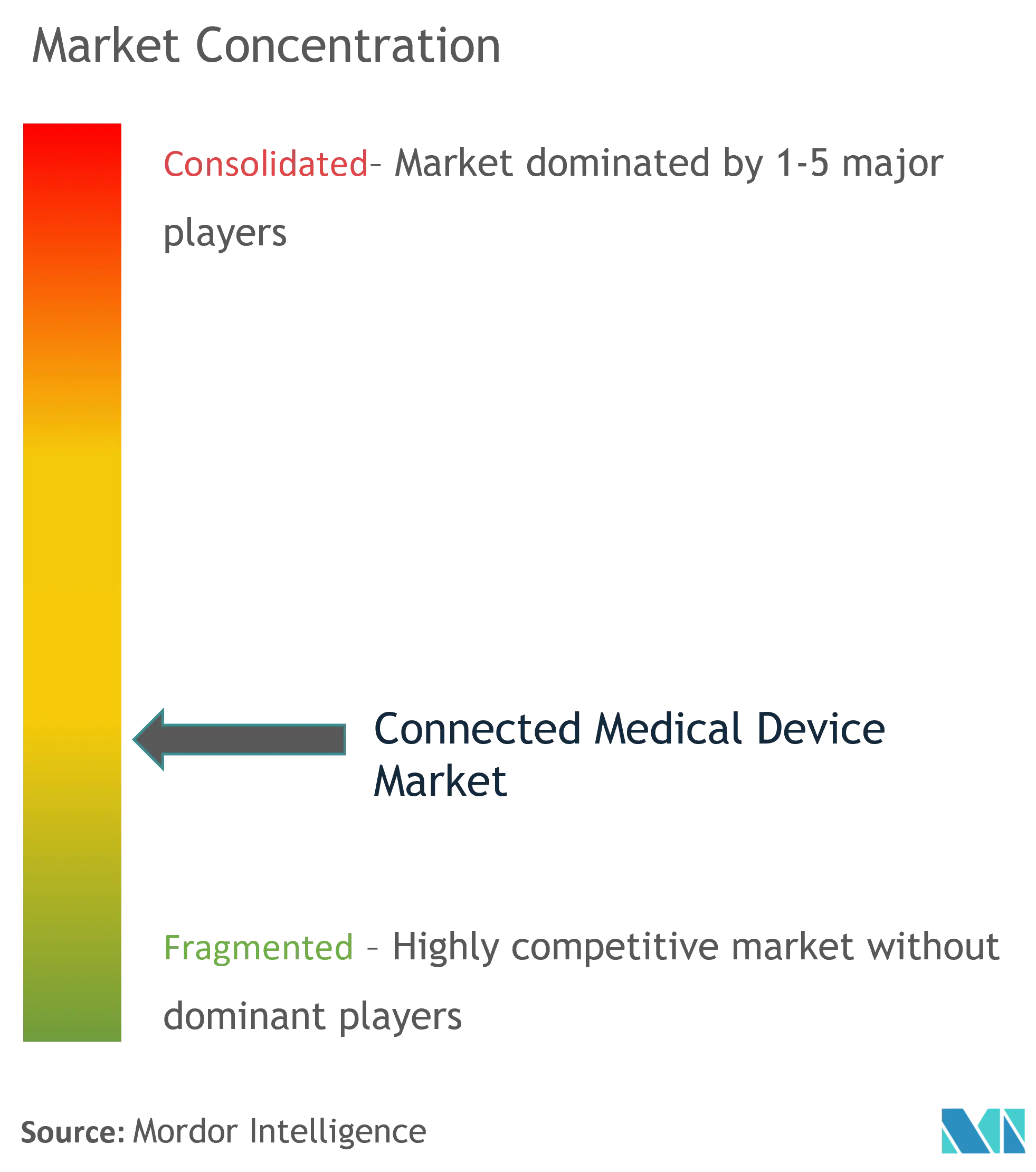
Connected Medical Devices Market News
- August 2022: Medtronic plc declared entering a strategic partnership with BioIntelliSense, a continuous health monitoring and clinical intelligence company, for the US hospitals only and 30-day post-acute hospital-to-home distribution rights of the BioButton multi-parameter wearable for straight, connected monitoring. The partnership allowed the Medtronic Patient Monitoring business to access a medical-grade device that primarily offered continuous vital sign measurements of general care patients in-hospital and post-discharge.
- March 2022: Microsoft Corp. declared updates to Microsoft Cloud for Healthcare and developments in cloud technologies for life sciences and healthcare with the general availabilities of its Azure Health Data Services. With the recent acquisition of Nuance Communications, Microsoft accelerates an organization's ability to assist others by leveraging trusted AI to address the most significant challenges transforming the future of healthcare.
- January 2022: Abbott announced the development of a new consumer bio wearable, Lingo, primarily built to detect critical body signals, like ketones, glucose, and lactate, helping people better understand their general health and take the required action.
Connected Medical Devices Industry Segmentation
The Internet of Medical Things enables medical devices to connect to the cloud and applications. Connected medical devices can also offer various portable diagnostic tools that can be well utilized for in-home collection and diagnosis. This connectivity could imply the benefit directly for both patients and healthcare service companies.
The connected medical device market is segmented by application (consumer (patient) monitoring, wearable devices, internally embedded devices, and stationary devices) and geography (North America, Europe, Asia-Pacific, Latin America, and Middle East and Africa). The market sizes and forecasts are present in value (USD million) for all the above segments.
| Application | Consumer (Patient) Monitoring | ||
| Wearable Device | |||
| Internally Embedded Device | |||
| Stationary Device | |||
| Geography | North America | United States | |
| Canada | |||
| Europe | Germany | ||
| United Kingdom | |||
| France | |||
| Rest of Europe | |||
| Asia-Pacific | China | ||
| Japan | |||
| South Korea | |||
| Rest of Asia-Pacific | |||
| Latin America | |||
| Middle East and Africa | |||
| Consumer (Patient) Monitoring |
| Wearable Device |
| Internally Embedded Device |
| Stationary Device |
| North America | United States |
| Canada | |
| Europe | Germany |
| United Kingdom | |
| France | |
| Rest of Europe | |
| Asia-Pacific | China |
| Japan | |
| South Korea | |
| Rest of Asia-Pacific | |
| Latin America | |
| Middle East and Africa |
Connected Medical Device Market Research Faqs
How big is the Connected Medical Device Market?
The Connected Medical Device Market size is expected to reach USD 75.99 billion in 2025 and grow at a CAGR of 14.98% to reach USD 152.71 billion by 2030.
What is the current Connected Medical Device Market size?
In 2025, the Connected Medical Device Market size is expected to reach USD 75.99 billion.
Who are the key players in Connected Medical Device Market?
https://www.gehealthcare.com/, https://www.honeywell.com/us/en, https://www.medtronic.com/us-en/index.html, https://www.abbott.com/ and https://www.philips.com/global are the major companies operating in the Connected Medical Device Market.
Which is the fastest growing region in Connected Medical Device Market?
Asia Pacific is estimated to grow at the highest CAGR over the forecast period (2025-2030).
Which region has the biggest share in Connected Medical Device Market?
In 2025, the North America accounts for the largest market share in Connected Medical Device Market.
What years does this Connected Medical Device Market cover, and what was the market size in 2024?
In 2024, the Connected Medical Device Market size was estimated at USD 64.61 billion. The report covers the Connected Medical Device Market historical market size for years: 2019, 2020, 2021, 2022, 2023 and 2024. The report also forecasts the Connected Medical Device Market size for years: 2025, 2026, 2027, 2028, 2029 and 2030.
Page last updated on: December 23, 2024

